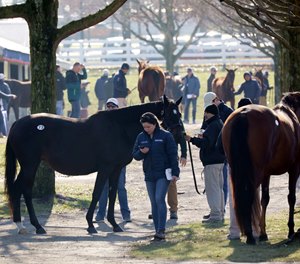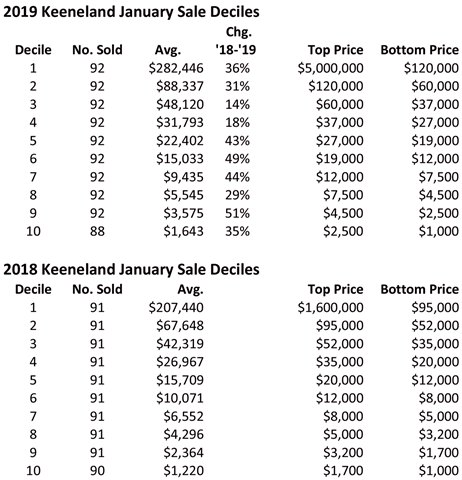Unusual Depth at the Keeneland January Sale


The Keeneland January Horses of All Ages Sale put up record-setting numbers when it wrapped up the final of four sessions last week.
The overall average of $51,048 from 916 horses sold set a sale record, exceeding the previous record of $50,182 in 1988. The $20,000 median equaled the sale record set in 2014 and was up 66.7% from 2018. Gross sales of $46,759,600 were the highest since 2008, but that year's sale grossed nearly $70.45 million from seven sessions.
Keeneland January has conducted either four- or five-session sales since 2010, and this year's auction had the highest gross among any of the others with four sessions. This year's gross was certainly helped by the bell-ringing sale of multiple grade 1 winner and champion Abel Tasman for $5 million to M.V. Magnier, and the top of the market—as expected—was strong.
Even when the metrics are setting records, however, previous auctions have shown the tide does not necessarily lift all boats. Some dinghies toward the lower end of the market often end up taking on water. This year's Keeneland January auction was surprising because it showed an unusual depth in trade.
BloodHorse MarketWatch monitors activity at different levels of the market by comparing changes in average price and price range by decile. For this year's January sale, every decile showed growth in average price when compared with 2018, which was not seen in either the 2-year-olds in training or yearling markets last year.
The top two January deciles reported growth in average price exceeding 30%. The highest decile's average increased 36% to $282,446, and the second-highest decile average was up 31% to $88,337. The price ranges for both deciles also shifted upward. The base price in the top decile was $120,000 compared with $95,000 for the base price of the top decile at the 2018 January sale. The base price for the second-highest decile was $60,000 this year compared with $52,000 for the same decile a year ago.
Growth at the top is nothing new, but this year's January sale showed double-digit growth at every decile, including a 51% increase in average at the ninth decile. Compare this with the deciles from the Keeneland September Yearling Sale, which showed growth in average price for only the top four deciles. (See the Oct. 1, 2018, edition of BloodHorse Daily for the September deciles.)
So what's driving the growth?
A couple of factors are likely at play. For one, sellers seem to be less discriminating about where a top horse is sold. Don't get me wrong, placement in the right sale is important, but the sellers' mantra as of late has been: If you have the goods, you're going to get paid. This has allowed some flexibility in where a horse is offered. Abel Tasman is this year's shining example.
Perhaps a more important influence has been the steady decline in the North American mare population, which dropped another 5% between 2017-18. The number of mares bred is down 12.4% since 2014. As the pool shrinks, it is the lower-quality and least productive mares that are weeded out. This culling by the market raises the overall quality of the mares left in production and makes broodmares and broodmare prospects with good credentials even more valuable.
The balance of supply and demand favored sellers at the Keeneland January sale this year, where the buyback rate also dropped to 22.4% from 25.9% a year ago. What a declining but higher-quality mare population does not change is the ever-present need for end-users to eventually buy and race those foals.

